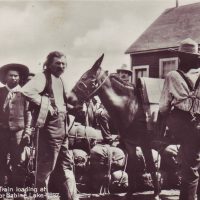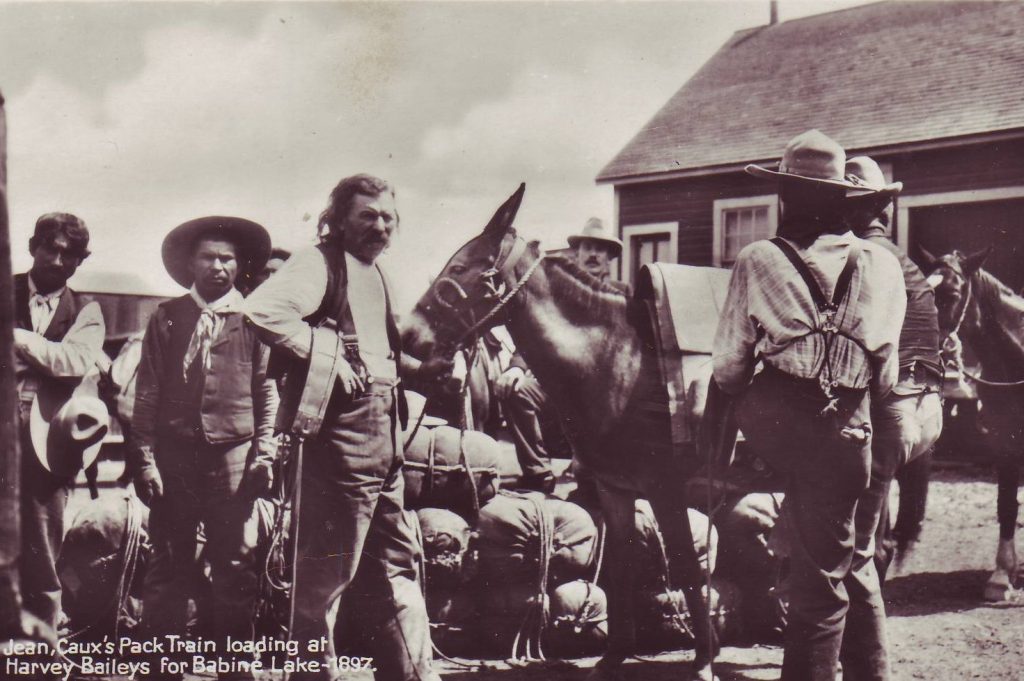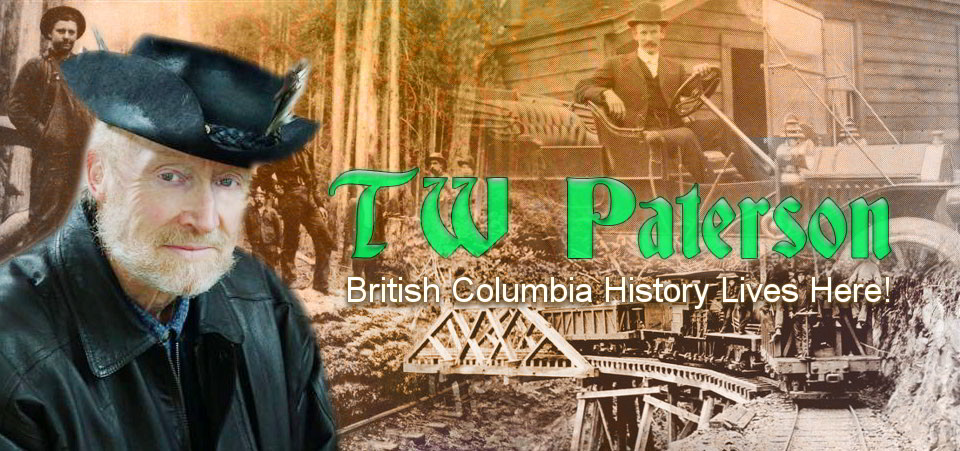Colourful Cataline was One of a Kind

With his Spanish sombrero, drooping Napoleon III mustachios and goatee, silk bandana, heavy wool shirt held in place by a bright-coloured sash, frock coat (on formal occasions), suspendered trousers, riding boots and spurs, Jean Jacques Caux—Cataline—was right out of a Frederick Russell painting.
But Cataline as he was known to one and all was real.
Not only that, he was bigger than life. Barrel-chested, with arms that seemed too long for his short body, he carried himself with the assurance of a man born to lead; a man with full confidence in his strength and ability to back up his word.
For those tempted to question his authority, two further essentials completed Cataline’s costume: a broad-bladed throwing knife in his boot and an iron mule shoe in his pocket!
Born in 1830 in Oleron, Sainte Marie, in what’s now southwest France, Jean Caux was not a French citizen (nor a Basque as some would have us believe), but a Bernois, as the Viscounty of Bearn was then an independent state.
Prior to his arrival in British Columbia in 1858, his career is something of a mystery.
Some accounts suggest that he left the Old Country because of political unrest, emigrating to Canada. Other biographers consider it likely that he followed the call of gold to California then joined the miners on the Fraser River in 1858 as one of a Mexican pack train.
Immediately upon his arrival in the new gold fields, he received the nickname that he’d carry for the rest of his life. Upon being asked his name, Caux, who spoke very little English, had replied, “Catalonia” in an attempt to explain where he was from. According to Victoria historian Prof. Douglas Leechman, “He apparently showed signs of recognition when Catalonia was mentioned and almost at once the nickname ‘Cataline’ became his.”
Making Cataline even more difficult to understand than his accent and mix of Spanish/French/English/Indian and Chinese, was his machine-gun way of speaking.
No wonder that it was said that he spoke a language of his own!

His claim to fame is as a freighter, or packer, during the Cariboo gold rush and beyond—all the way to 1912, for an amazing 54 years. With as many as 50 mules in a train, Cataline and his men, mostly Chinese as he found them to be the best workers and the most reliable, serviced the gold camps between Yale and Barkerville, a 400-mile run. At an average of 10 miles a day when loaded, each animal carried up to 300 pounds of mixed goods on ‘roads’ that often were little better than game trails. He also had a reputation for always getting the goods through the worst of terrain and the worst of weather and for looking after his animals.
Although illiterate, Cataline had a good head for business and an exceptional, even photographic memory. There’s also a classic tale about his sense of fair play. Once forced to borrow money from a bank to cover a bad season, he’d had to put up 75 horses for collateral. After he’d paid off the loan in his preferred denomination of 20-dollar gold pieces, the banker suggested that he put the rest of his money in the bank for safekeeping. Cataline asked him how many horses he had (for collateral).
None, he was told. To which he’d replied, he’d “keepa de mon” himself.
Twice, he was known to draw his big Mexican knife. The first time was for dramatic effect when a mob of American miners began agitating against British rule north of the 49th parallel. Cataline didn’t change their minds but he did get them to leave him out of their protesting. The second time, in later years, occurred when he was being badgered by several young drunks in a saloon.
Without responding to their jibes, he crossed the room and, for several seconds, studied a mark on the wall. Still not speaking, he started to walk away, only to draw his blade (shades of Crocodile Dundee!) and throw it in a single motion, burying it deep in the wall, in the very spot he’d chosen as a bull’s eye.
Suffice to say, the hectoring stopped instantly.
After the arrival of the railway, Cataline moved operations to Ashcroft then Quesnel then Hazelton, following the latest mining activities. Years before, he’d married a woman from Spuzzum who bore him several children. Long after they separated, he continued to support his family, always in gold pieces.
It was at Hazelton that Cataline’s long trail finally came to an end with his retirement in 1912. He died 10 years later when well into his 80s. Only once in all those years had he worn a pair of socks—outside his boots to prevent his slipping on treacherous ice.
In 2004, when Seattle’s Public Television Station, KCTS, aired Vancouver filmmaker Sylvie Peltier’s The Legend of Cataline, a University of British Columbia professor described Jean Caux aka Catlaine as a “fascinating character because he’s representative of a very significant part of British Columbia’s history, and because in a sense, he’s an enigma”.
I’d read about and wanted to write about Cataline for years and finally, in 2012, acquired the accompanying postcard at the Ladysmith Diggers & Collectors Show in Chemainus.
This year, finally, Cataline has been immortalized between the covers of a book by authors Susan Smith-Josephy and Irene Bjerky. They’ve told his story in Cataline: The Life of B.C.’s Legendary Packer. It’s a “splendid book [that] captures character of tough-as-nails pioneer and legendary mule train packer,” to quote The Province’s Tom Sandborn,
He was tough-as-nails, all right. They’re just not making characters like Cataline any more, sad to say.

found this tidbit on Cataline amongst our family paperwork as our gggrandfather Blas Leon and his son Serapio Leon both knew and worked with Cataline..”Jacques Caux, the famous packer who was known far and wide as Cataline, had a contract with the B. C. government to pack supplies for the telegraph stations between Hazelton and Dawson, Yukon Territory. He had 83 horses and mules which had pastured at Dog Creek during the winter. His crew consisted of Serape Leon, a Mexican, Pablo Tressiera, a Spaniard, Dave McDaniels and William Vaughn from the states, two Indians, Skokum Joe and Antwyne from the High Bar reserve and Rufe Evans, a big husky Irishman.
from Ernie Thoresen journal “The Mexican Serape taught me to throw the diamond hitch “Above all else keed, you must be vera queek, Done stand around move fast. Dat way you get along weet everybody.”
“Serape the Mexican was our blacksmith and expert shoer of horses.”
Late in the fall of 1912, Pablo Tressiera and Serape Leon and me (Ernie Thoresen) took the horses and mules to pasture at the Old Semlin Ranch which is located on the road between Cache Creek and Savona.””
as a sidenote Blas Leon had come north from Mexico with his childhood friend Jesus Garcia who would become well known in what is now Merritt area.His son Serapio settled in Jesmond and married Elizabeth Hinck from Big Bar. He worked with Cataline and then the Gang Ranch and Empire Valley Ranch.
in your photo of Cataline the fellow standing behind him is George Tamaxkain who shows up in several Cataline photos over the years.
Chief Joseph Moses was also known as High Bar Joe, and Cataline called him Skookum Joe (Skookum is a Chinook trade language word for “strong”), as he worked with him packing horses from the old Spanish Ranch just outside Clinton towards Kelly Lake. He also scribed for other people and the court system, writing English, Chinese, Spanish, Chinook, and Shuswap languages in shorthand.
Your family research is quite the treasure trove, John–you never cease to amaze me, and I’m pleased you allow me to share it with my readers. It’s funny(?) that I, the professional historian, has never researched his own family and knows very little, in fact, beyond my parents and my maternal grandparents. One day… TW
oh thanks TW, yes sometimes i scare myself lol…hope you take the time to research your own tree! its surprising some of the things that get uncovered. Who would have guessed their ancestor rode with the legend Cataline from the Cariboo to Dawson, Yukon and back…the stories those guys took to their graves! wish i could sit around a campfire with Serape and hear some of them.
Did Catalina name Spanish Lake near Likely?
Sorry, Tanya, can’t answer this one. –TW
I was in Hazelton a few days ago and went to the Gitanmaax cemetary to view Cataline’s burial monument. Apparently a cairn (pyramid constructed of rocks?) with a brass plaque. I looked for an hour all along the “old area” of the cemetary edge overlooking the valley below. Could not find anything other than a small, 2 ft high, mortared rock cairn, but no identification. A worker in the cemetary had no idea of where the burial may be. Sadly.
Do you suppose someone stole his plaque from that cairn?
I thought that the cairn that I found was not likely the burial site, it was only 3ft tall, and I didn’t notice any remnants of fasteners, presuming that the plaque had fasteners that were set into the mortar of the cairn. I have not found any pictures of what the cairn actually looks like or how tall it is/was. What I found was certainly much more lowley than the traditional historic markers that were erected around the province, such as the one identifying Fort Alexandria, between Quesnel and Williams Lake.
Thank you for your comment, Mark. A privately installed cairn, perhaps? Too bad the plaque is missing. –TW